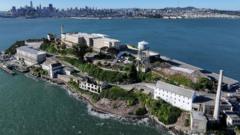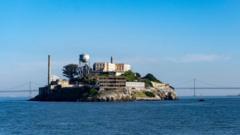While Trump claims it symbolizes law and order, logistical and financial hurdles make the reopening seem implausible.
**Trump's Ambitious Proposal to Reopen Alcatraz: A Pipe Dream?**

**Trump's Ambitious Proposal to Reopen Alcatraz: A Pipe Dream?**
Former President Trump's plan to revive the infamous Alcatraz prison has met skepticism from experts and historians.
The price to keep prisoners at Alcatraz was significantly higher than elsewhere in the federal prison system. Former President Donald Trump has reiterated his proposal to reopen Alcatraz Island, once infamous for housing dangerous criminals, pitching it as a future facility for high-risk inmates. Trump envisions the prison—closed since 1963 and now a historic attraction—as a renewed stronghold of law enforcement. However, experts question the feasibility of restoring the dilapidated site, calling the plan unrealistic.
Located about 1.25 miles from San Francisco, Alcatraz began as a military fort before transforming into a federal penitentiary in 1934. It famously housed notorious criminals such as Al Capone, becoming a symbol of inescapability due to the surrounding freezing waters and strong currents of the bay. The prison gained further notoriety through film portrayals, like the 1979 classic "Escape from Alcatraz," featuring Clint Eastwood.
Alcatraz officially closed in 1963, largely due to high operational costs—almost three times higher than other federal institutions. Today, it serves as a museum, attracting over 1.4 million visitors annually. Christine Lehnertz, leader of the Golden Gate National Parks Conservancy, remarked on Alcatraz as a historic site that offers lessons and stories relevant to today.
While Trump's proposal suggests a return to this taxpayer-funded detention center, similar ideas had emerged in the past, notably during the Reagan administration, which considered it for housing Cuban refugees in the 1980s. However, logistical challenges prevented its selection.
In early May, Trump introduced his intention to reopen the prison, expressing concerns over rising crime rates in America. "We need law and order in this country," he stated at a White House press event, acknowledging the prison’s current state as "rusting and rotting." His border czar, Tom Homan, supported the idea, speculating that Alcatraz could be used for housing significant public safety threats.
Officials from the Justice Department implied they are exploring ways to revitalize the prison. However, former Bureau of Prisons Director Hugh Hurwitz dismissed these efforts, citing critical repair needs and impracticalities related to modern prison standards—security upgrades, sanitation, and essential utilities remain major concerns. Additionally, Jolene Babyak, an Alcatraz historian, pointed out severe sanitation issues, emphasizing that practical outdated practices would no longer suffice.
Historically, Alcatraz is known for incurring operational expenses that skyrocketed past modern norms – estimates put potential costs for its revival at over $500 per inmate. Even as restoration attempts were made by the National Park Service since the facility’s closure, the extent of deterioration calls into question any viable reopening plan.
In summary, while the conversation sparked by Trump’s ambitious proposal to reopen Alcatraz captures public imagination, experts agree on its impracticality, leaving many to wonder if this is just another chapter in the ongoing saga of the infamous prison.
Located about 1.25 miles from San Francisco, Alcatraz began as a military fort before transforming into a federal penitentiary in 1934. It famously housed notorious criminals such as Al Capone, becoming a symbol of inescapability due to the surrounding freezing waters and strong currents of the bay. The prison gained further notoriety through film portrayals, like the 1979 classic "Escape from Alcatraz," featuring Clint Eastwood.
Alcatraz officially closed in 1963, largely due to high operational costs—almost three times higher than other federal institutions. Today, it serves as a museum, attracting over 1.4 million visitors annually. Christine Lehnertz, leader of the Golden Gate National Parks Conservancy, remarked on Alcatraz as a historic site that offers lessons and stories relevant to today.
While Trump's proposal suggests a return to this taxpayer-funded detention center, similar ideas had emerged in the past, notably during the Reagan administration, which considered it for housing Cuban refugees in the 1980s. However, logistical challenges prevented its selection.
In early May, Trump introduced his intention to reopen the prison, expressing concerns over rising crime rates in America. "We need law and order in this country," he stated at a White House press event, acknowledging the prison’s current state as "rusting and rotting." His border czar, Tom Homan, supported the idea, speculating that Alcatraz could be used for housing significant public safety threats.
Officials from the Justice Department implied they are exploring ways to revitalize the prison. However, former Bureau of Prisons Director Hugh Hurwitz dismissed these efforts, citing critical repair needs and impracticalities related to modern prison standards—security upgrades, sanitation, and essential utilities remain major concerns. Additionally, Jolene Babyak, an Alcatraz historian, pointed out severe sanitation issues, emphasizing that practical outdated practices would no longer suffice.
Historically, Alcatraz is known for incurring operational expenses that skyrocketed past modern norms – estimates put potential costs for its revival at over $500 per inmate. Even as restoration attempts were made by the National Park Service since the facility’s closure, the extent of deterioration calls into question any viable reopening plan.
In summary, while the conversation sparked by Trump’s ambitious proposal to reopen Alcatraz captures public imagination, experts agree on its impracticality, leaving many to wonder if this is just another chapter in the ongoing saga of the infamous prison.





















